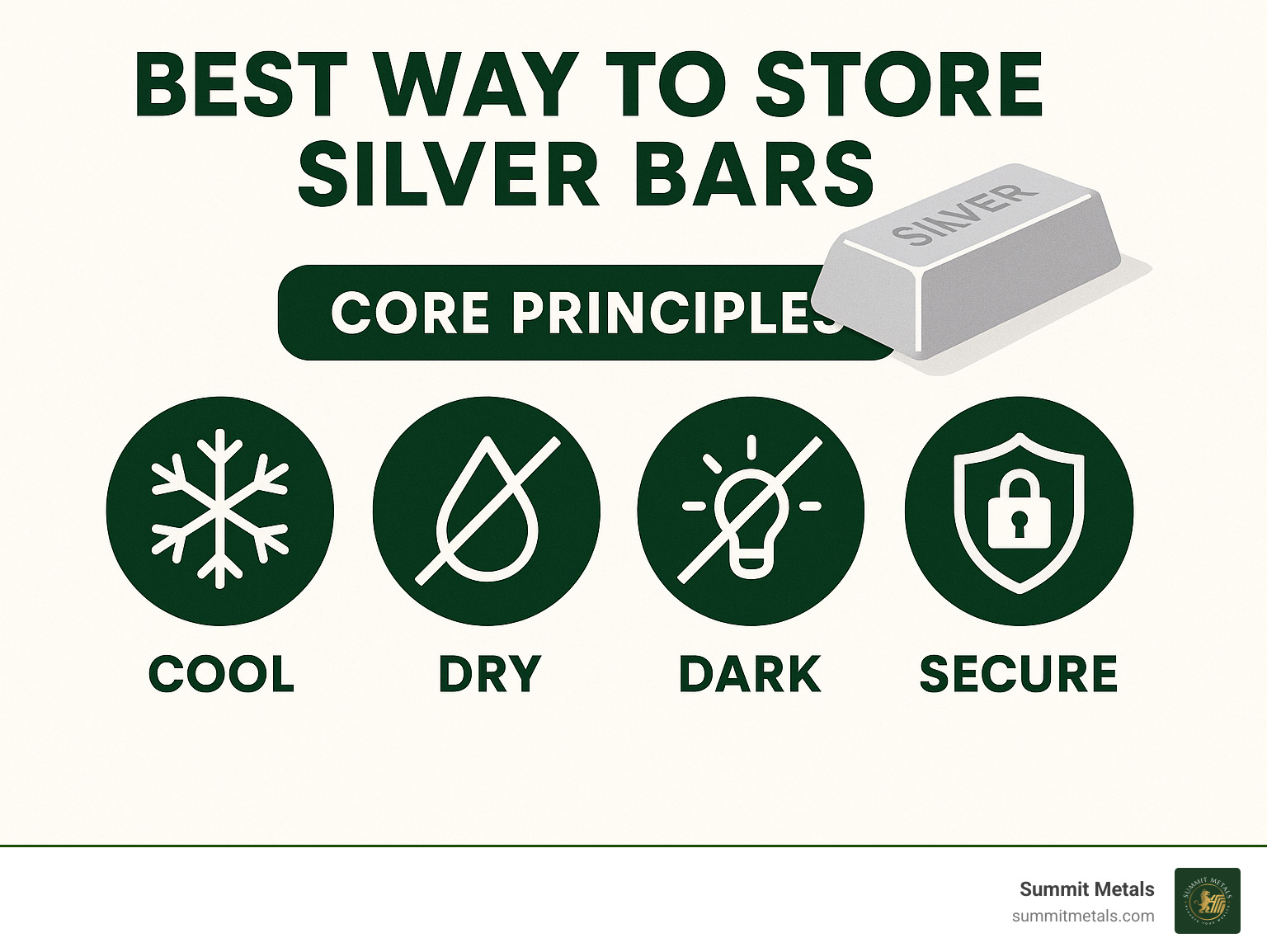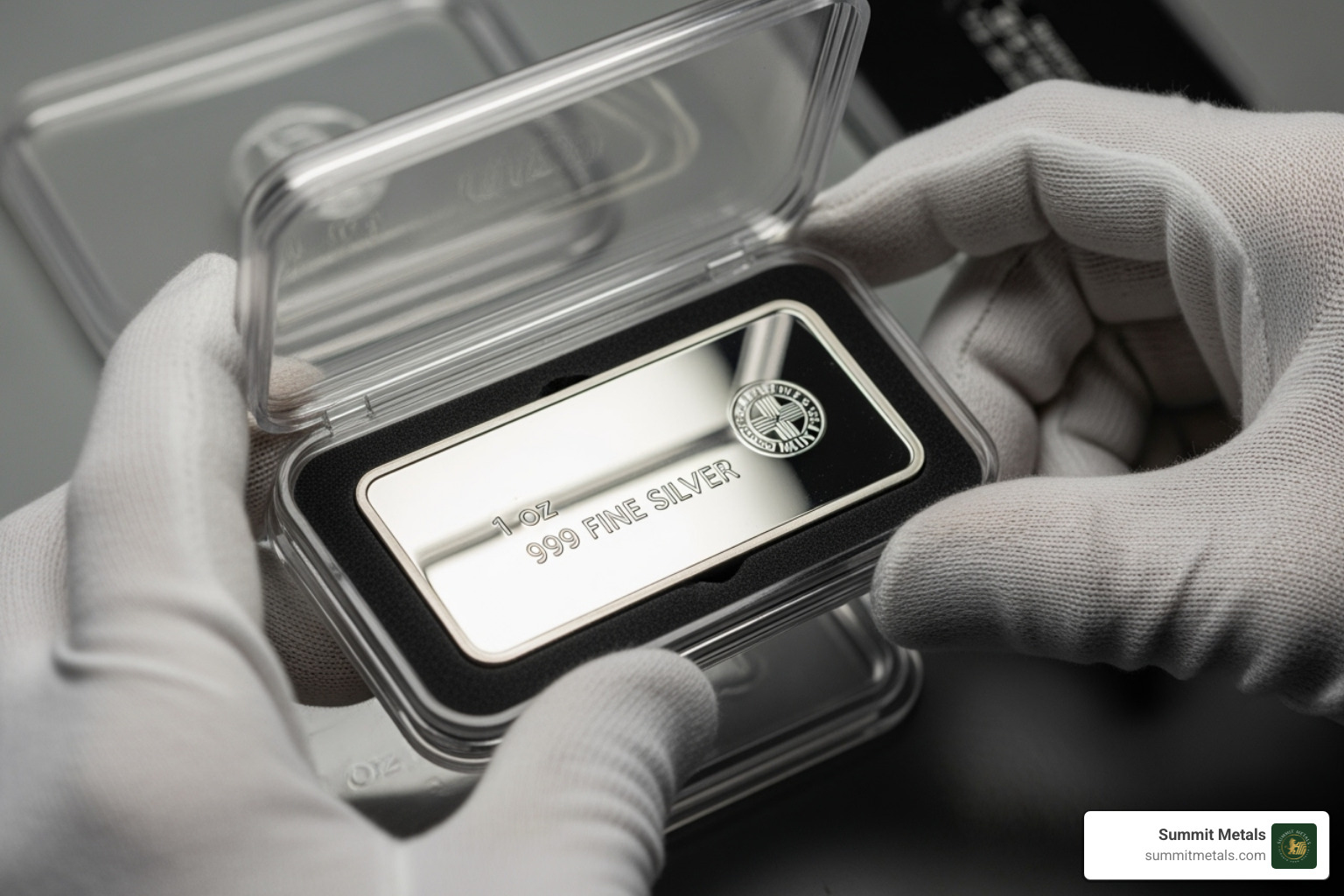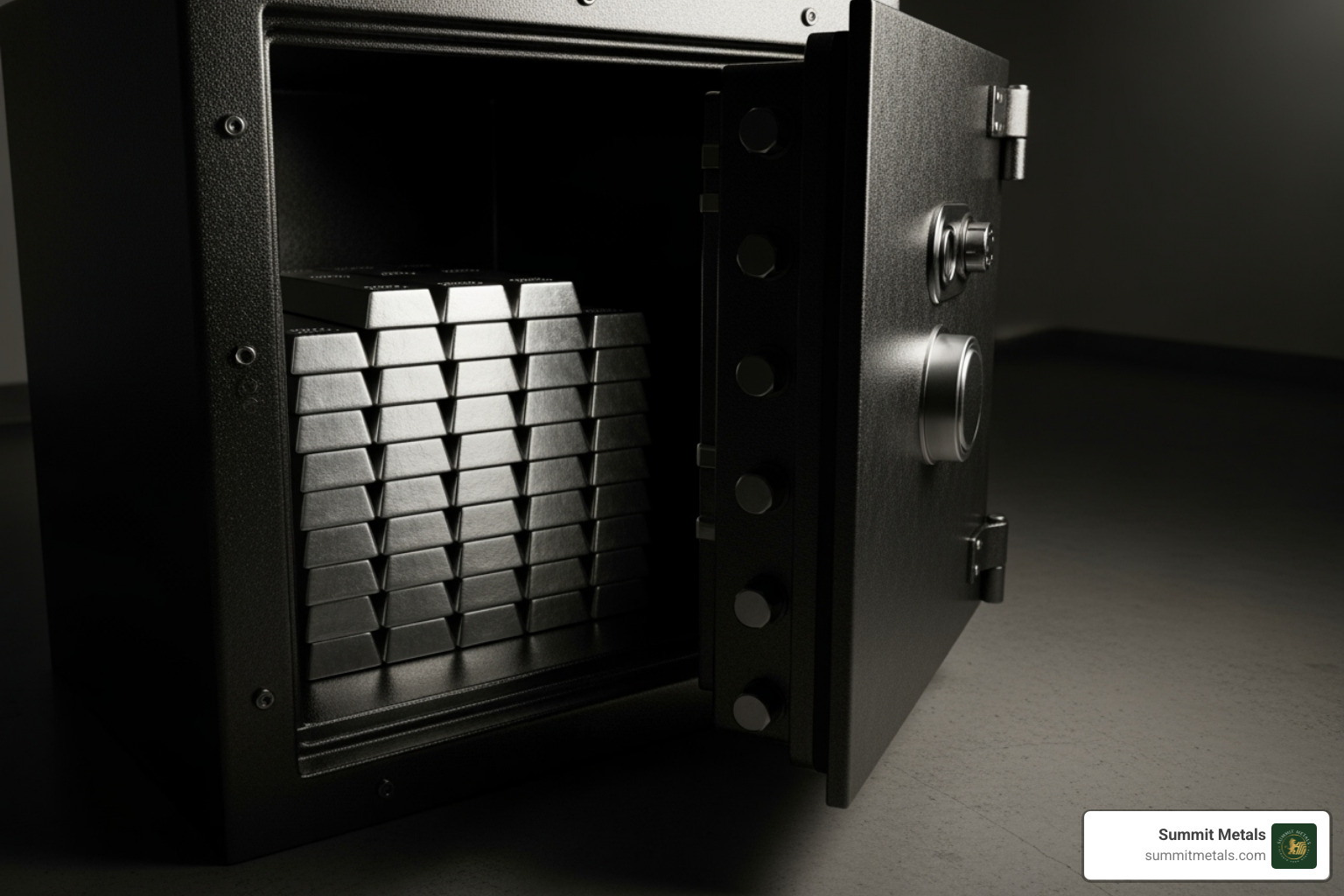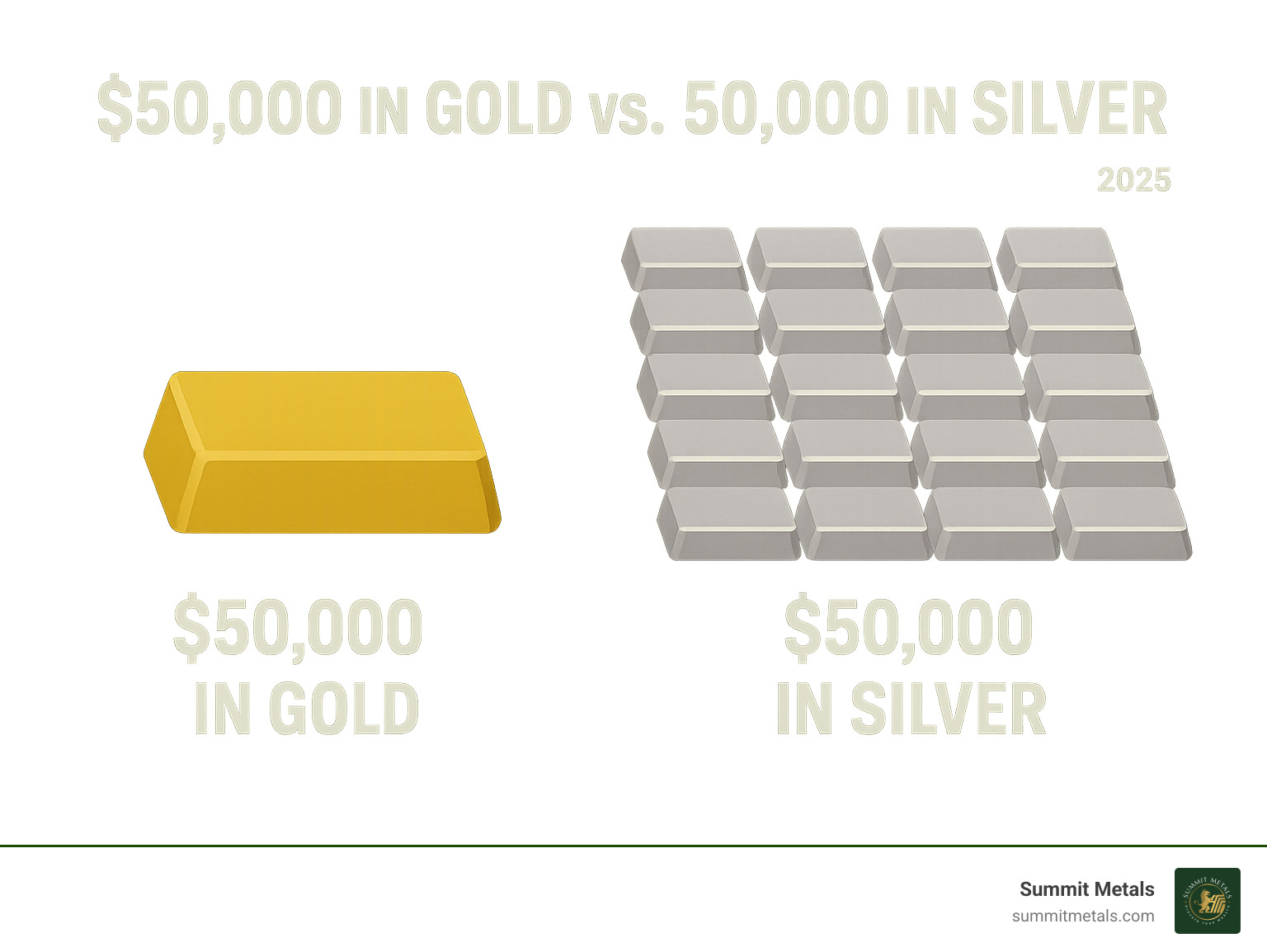Securing Your Silver Bars: An Essential Guide
The best way to store silver bars involves keeping them in a cool, dry, dark, and secure place. This means using proper, non-reactive packaging, handling them minimally, and choosing a secure storage location, whether at home or with a professional vault service.
Physical investments like silver are a great way to protect your wealth against inflation and market changes. But silver is unique. For the same value, it takes up a lot more space than gold—as much as 128 times more. It also easily tarnishes when exposed to air and humidity.
This is why how you store your silver matters. Proper storage protects your investment, keeps your bars looking good, and prevents damage or loss. This guide will show you how to best care for your silver bars.
I'm Eric Roach. With over a decade on Wall Street, guiding Fortune-500 companies, I've learned that safeguarding assets is crucial, and that understanding the best way to store silver bars is a key part of protecting your wealth. This guide will help you apply those same principles to your precious metal investments.

The Foundations of Silver Preservation: Environment and Handling
Protecting your silver investment begins with understanding its unique properties. Unlike gold, which is remarkably stable, silver is more reactive and susceptible to environmental factors. Our goal is to maintain its condition for long-term safekeeping, ensuring your assets retain their value and luster.

To explore more about securing your investments, check out our Top Tips for Precious Metals Storage: Secure Your Investments.
Controlling Environmental Factors
Silver's worst enemies are humidity and fluctuating temperatures. These conditions can accelerate tarnishing and, in extreme cases, even lead to corrosion. To keep your silver in pristine condition, we recommend maintaining optimal environmental controls:
- Temperature Control: Aim for a stable temperature range between 60°F and 70°F (15°C to 21°C). Extreme heat or cold, or rapid changes between them, can cause condensation, which is a major culprit for tarnish.
- Humidity Control: This is perhaps the most critical factor. We advise maintaining a humidity level below 50%. High humidity creates the perfect environment for silver to react with airborne chemicals.
- Air Exposure: The less your silver is exposed to air, the better. Air contains sulfur compounds that cause tarnishing.
- Light Exposure: While not as damaging as humidity, direct sunlight can also contribute to tarnish and discoloration over time. Store silver in dark places.
This means avoiding places like basements, attics, or garages that are prone to high humidity and temperature swings. A climate-controlled room within your home is often ideal. For a deeper dive into how moisture affects your precious metals, read our Scientific research on humidity and tarnish.
The Best Way to Store Silver Bars to Prevent Tarnishing
Tarnishing is silver's natural enemy. It's a chemical reaction, primarily with hydrogen sulfide (sulfur compounds) in the air, creating a black layer on the silver's surface. While tarnish on bullion bars doesn't typically affect their intrinsic metal value, it can reduce their aesthetic appeal and potentially their resale value if not managed. For numismatic coins, tarnish can severely diminish collector value.
Here's how to combat it:
- Anti-Tarnish Solutions: Invest in anti-tarnish bags or cloths. These materials are treated to neutralize airborne sulfur compounds, creating a protective barrier around your silver.
- Inert Materials: Ensure any packaging or storage containers are made from inert, non-reactive materials. Avoid polyvinyl chloride (PVC) containers, as chemicals from PVC can leach onto the silver, causing irreversible damage and discoloration. Similarly, steer clear of regular plastic bags, vinyl, and rubber bands, which contain chemicals that accelerate tarnishing.
- Moisture Absorption: Place silica gel packets inside your storage containers. These small packets are excellent at absorbing excess moisture, helping to keep the humidity low within the confined space.
- Acid-Free Protection: Wrap individual bars in acid-free tissue paper or acid-free cotton fabric before placing them in containers. This provides an additional layer of physical and chemical protection.
- Recommended Storage Containers: Look for airtight containers specifically designed for bullion. Many quality storage containers are available that offer both physical protection and a seal against environmental elements.
Understanding the nuances of silver quality, especially for bars, can also inform your storage choices. Learn more in our guide, Bar None The Best: Understanding Certified Silver Bars.
Best Practices for Handling and Cleaning Silver
How you handle your silver is almost as important as where you store it. Silver is a relatively soft metal and can easily scratch or react to skin oils.
- Use Cotton Gloves: Always handle your silver bars with clean cotton gloves. The natural oils, salts, and acids from your bare hands can leave fingerprints that, over time, will etch into the silver and accelerate tarnishing.
- Handle by the Edges: When picking up coins, hold them by their edges to minimize surface contact. For bars, handle them minimally and carefully.
- Soft Surfaces: Always place silver bars on a soft, clean surface when moving or inspecting them. This prevents scratches and dings. Avoid stacking bars directly without protection, using soft, non-abrasive cloths or padded materials to separate them.
- To Clean or Not to Clean: This is a common dilemma. For standard silver bullion bars, cleaning is generally not recommended unless absolutely necessary. Tarnishing on bullion is mostly cosmetic and does not diminish its intrinsic metal value. Dealers will buy back tarnished bars at the same buyback rate. For numismatic (collectible) coins, cleaning can drastically reduce their value by removing their original patina. Many avid coin collectors prefer the natural tarnish on a coin as it adds character.
- Gentle Cleaning Methods (If Necessary): If you must clean tarnished silver (e.g., for presentation), use only silver-safe cleaning products. Avoid abrasive chemicals or harsh rubbing, as these can scratch the surface. A mild soap and warm water solution, gently applied with a soft cloth, followed by thorough drying, is usually sufficient. Never rub the surface of the silver when cleaning. Ensure bars are completely dry before returning them to storage.
Choosing Your Fortress: The Best Way to Store Silver Bars at Home vs. Professional Vaults
When it comes to storing your silver, you're essentially choosing between having your treasure chest in your bedroom closet or in Fort Knox. Each approach has its merits, and honestly, most savvy investors don't pick just one. They diversify their storage locations as a smart risk mitigation strategy—keeping some silver at home for easy access and emergencies, while storing the bulk of their investment in professional facilities.

The key is balancing accessibility with security. You want to be able to get to your investment when you need it, but you also want to sleep soundly knowing it's protected. For more insights on this balance, check out The Ultimate Guide to Gold and Other Precious Metals Storage.
Home Storage: Pros, Cons, and Security
There's something deeply satisfying about being able to walk over to your safe and touch your silver investment whenever you want. Home storage gives you complete control and immediate accessibility—no appointments, no business hours, no waiting. If there's an emergency or you simply want to admire your stack, it's right there.
But let's be real about the downsides. Theft risk is probably your biggest concern. Experienced burglars know all the "clever" hiding spots you might think of. They check freezers, behind picture frames, and in bedroom closets as standard procedure. Natural disasters present another serious threat—fires and floods don't discriminate between your family photos and your silver bars.
Here's where discretion becomes your best friend. The fewer people who know about your home silver stash, the safer it is. We recommend telling only one completely trusted person, like your spouse or an adult child, about your storage location. Resist the urge to show off your collection on social media or brag about it to neighbors.
Some investors use decoy safes filled with less valuable items to throw off potential thieves. Others create multiple hiding spots throughout their home. Think of it as the "don't put all your eggs in one basket" principle applied to hiding places.
Security Measures: The Best Way to Store Silver Bars Safely at Home
If you're going the home storage route, investing in proper security measures isn't optional—it's essential. The best way to store silver bars at home starts with a quality safe, but it doesn't end there.
Choosing the right home safe is crucial. Look for models with fireproof ratings (UL-15 specification or higher is solid) and water resistance. Weight matters too—a 500-pound safe isn't something a burglar can casually carry out your front door. You can find quality options in our home safe collection.
Don't just buy a heavy safe and call it good. Bolting it down to your floor or wall makes it virtually impossible to remove, even with equipment. This simple step transforms your safe from "really difficult to steal" to "not worth the effort."
Consider adding an alarm system to your security setup. Modern monitored systems can alert authorities even when you're not home. Inventory management is another critical piece—maintain detailed records with photos, serial numbers, and purchase dates. Keep this documentation separate from your silver, preferably in a secure digital format or off-site location.
Professional Storage: Summit Metals Vaults and Depository Services
For serious silver investors, professional storage offers security that's simply impossible to replicate at home. Summit Metals partners with top-tier secure depositories to provide world-class protection for your precious metals investment.
The security advantages are impressive. We're talking about armed guards, 24-hour surveillance, biometric scanners, metal detectors, and bulletproof doors. These facilities are designed to withstand sophisticated theft attempts that would make Hollywood heist movies look amateur.
Your silver is fully insured against theft, damage, or loss when stored through Summit Metals' depository services. The facilities maintain optimal climate control to prevent tarnishing and preserve your silver's condition. Regular independent audits verify all holdings, ensuring complete transparency and accountability.
The trade-off is limited access. You can't just pop by at midnight to check on your silver. Most facilities operate during business hours and may require advance notice for visits. There are also annual fees, typically ranging from 0.20% to 0.30% of your bullion's value per year. Prices shown are at the time of this publication.
We offer both segregated and allocated storage options. With segregated storage, your specific bars are kept in a dedicated, individually sealed compartment—they never get mixed with other clients' holdings. This is often the preferred choice for investors who want to know their exact bars are waiting for them.
Learn more about our secure, insured storage options through Summit Metals' depository services.
Comparing Home Storage vs. Summit Metals Professional Vaults
| Feature | Home Storage | Summit Metals Professional Vaults |
|---|---|---|
| Accessibility | Immediate, 24/7 | Restricted (business hours, appointments) |
| Security Level | Varies (depends on safe, home security) | Highest (armed guards, advanced tech, climate control) |
| Annual Cost | Initial safe purchase, potential insurance rider | Competitive fees (typically 0.20% to 0.30% of value per year) Prices shown are at the time of this publication. |
| Insurance | Often limited by homeowner's policy, needs rider | Fully insured against theft, damage, loss |
| Capacity | Limited by safe size and space in home | Virtually unlimited |
| Privacy | High personal risk if location is compromised | Extremely high, no personal risk of findy |
Practical Considerations: Space, Weight, and Insurance
Beyond environmental controls and security, the sheer physical properties of silver present unique storage challenges. Planning for these aspects is crucial for any long-term investment strategy.

For those looking to expand their stack, our guide on Stacking Silver: Here's Where to Buy 15 Kilos of Silver Bars offers further insights.
The Silver Stacker's Dilemma: Space and Weight
This is where silver truly differs from gold. For the same monetary value, silver takes up significantly more space and weighs considerably more:
- Space Comparison: Silver takes up as much as 128 times more space than gold for the same dollar value. For example, $2,000 worth of silver is about 87 ounces, while the same value in gold is only 1 ounce. A one-ounce American Silver Eagle coin is significantly larger than a one-ounce American Gold Eagle coin; your pants pocket would have to hold 70 of them, and they'd weigh almost 5 pounds!
- Weight Comparison: $50,000 worth of gold weighs about 2.6 pounds—but the same value of silver would weigh about 189 pounds. Imagine trying to store that!
- Monster Boxes: A standard monster box (often used for bulk silver coins like American Silver Eagles) holds 500 coins. While efficient for their purpose, these boxes still have considerable dimensions (e.g., a monster box of 500, 1-ounce American Silver Eagle coins measures 15” X 8.5” X 4.5”).
- Floor Load Considerations: If you're accumulating a substantial amount of silver at home, consider the weight on your floors, especially if storing in a basement or upper level. A large collection can exert significant pressure.
- Planning for Growth: As your collection grows, your storage needs will evolve. What works for a few bars might be completely impractical for a hundred. This is why diversifying your storage locations becomes increasingly important.
Insuring Your Investment
Regardless of where you store your silver, insurance is a non-negotiable step to protect your investment.
- Homeowner's Policy Limitations: Most standard homeowner's or renter's insurance policies have very limited coverage for precious metals, often capping it at a few thousand dollars. This is rarely enough to cover a significant silver collection.
- Precious Metals Riders: You'll likely need to add a specific rider or endorsement to your existing policy to adequately cover your bullion. Be aware that some insurers may require specific security measures (like a bolted-down safe) for such coverage.
- Specialized Insurance Policies: For very large collections, consider a specialized precious metals insurance policy. These policies are designed specifically for bullion and offer comprehensive coverage.
- Documenting Your Collection: To ensure any claim is successful, maintain detailed records: purchase receipts, photos of each bar, serial numbers (if applicable), and an updated inventory list.
- Cost of Vault Insurance: If you opt for professional vault storage, your silver is typically fully insured. The cost for additional insurable interest within a high security facility like ours will usually be between 0.20% to 0.30% of the value of your bullion per year as an admin fee. Prices shown are at the time of this publication. This provides peace of mind knowing your assets are protected.
The Problem with Bank Safe Deposit Boxes
While seemingly a convenient option, bank safe deposit boxes come with significant drawbacks, especially for storing bulky silver:
- Lack of Federal Regulation: There are no federal laws that govern safe deposit boxes, meaning banks are not required to compensate for loss or damage. Unlike bank deposits, contents are not FDIC-insured.
- Limited Access: Access is restricted to banking hours and days, meaning you can't access your silver during evenings, weekends, or federal holidays. As we saw during the COVID lockdowns, access can become even more difficult or impossible during crises.
- Risk of Loss or Damage: Despite bank security, incidents of missing boxes or contents being lost due to natural disasters (like the tsunami in Japan in 2011) have occurred.
- Space Constraints: Bank safe deposit boxes are often small, making them impractical for storing large quantities of silver due to its bulk and weight.
- Potential for Asset Seizure: In certain legal or emergency situations, authorities can freeze or seize contents without your consent.
Given these limitations, we generally advise against using bank safe deposit boxes as the primary storage solution for significant silver investments.
Frequently Asked Questions about Storing Silver
You've learned a lot about preserving your silver, from controlling environmental factors to choosing the right fortress for your precious metals. Now, let's tackle some of the most common questions that often pop up for silver stackers.
Should I keep my silver bars in their original mint packaging?
This is a fantastic question, and the answer often depends on the type of silver you have! For premium or numismatic items, like special edition coins or bars with unique designs, keeping them in their original mint packaging is usually the best way to store silver bars for preserving their condition and maximizing potential resale value. This packaging often includes protective capsules or sealed wraps that protect against handling and environmental factors. Think of it like keeping a collectible toy in its original box—it just holds more value that way!
However, if you're dealing with generic bullion bars (the kind you buy purely for their metal content), the original packaging isn't quite as critical for value. In fact, you might find it more practical to remove them from bulky packaging to fit them into more space-efficient storage containers. Just remember to use those cotton gloves and follow all the handling tips we discussed earlier!
Does tarnish reduce the value of my silver bars?
Ah, the dreaded tarnish! That dark discoloration that appears on silver can certainly be an eyesore, but does it actually hurt your investment? Here’s the good news: for standard bullion bars, tarnish typically does not reduce the intrinsic metal value. Dealers usually buy these bars based on their pure silver weight and purity, regardless of a little cosmetic tarnish. They'll melt it down anyway!
However, it's a completely different story for numismatic or collectible coins and bars. For these items, tarnish can significantly decrease their collector value. Collectors often value the original "patina" or pristine condition, and any discoloration can be a big turn-off. So, while your 10 oz silver bar might still fetch its full melt value even if it's a bit oxidized, that rare, proof coin might lose a lot of its premium.
How much silver is too much to store at home?
This is a very personal question, and there's no one-size-fits-all answer! What's "too much" silver to store at home really depends on a few factors: your personal comfort level, the security of your home and safe, and of course, the overall value of your holdings.
Many savvy investors take a balanced approach. They might keep a smaller, easily accessible amount of silver at home for emergencies or quick access. This could be enough to handle immediate needs or feel the tangible security of their investment. However, for the bulk of their precious metal investment, they opt for a professional, insured depository. This strategy helps to significantly mitigate risk, offering peace of mind that comes with top-tier security and insurance. It's all about finding that sweet spot between accessibility and ultimate protection for your hard-earned assets.
Conclusion: Securing Your Silver for the Future
So, what's the best way to store silver bars? As we've explored, it's not a single answer, but rather a thoughtful strategy custom to your unique needs. It comes down to keeping your precious silver in a cool, dry, dark, and secure environment. Remember those core principles we talked about? They're your silver's best friends! Properly handling your bars with cotton gloves and resisting the urge to clean them are also vital steps in preserving their long-term beauty and value.
Your silver is a valuable asset, and protecting it means finding the sweet spot between easy access for emergencies and top-tier security for your long-term wealth. For many savvy investors, the ultimate peace of mind comes from a balanced approach: keeping a small, accessible amount of silver safely at home, while entrusting the bulk of their investment to a professional, insured depository. It’s like having your cake and eating it too – immediate access when you need it, and robust protection for the rest.
At Summit Metals, we're dedicated to helping you safeguard your investments every step of the way. As your silver collection flourishes and grows, diversifying your storage methods provides the strongest possible protection for your hard-earned assets. Want to learn more about professional, secure options that can help your precious metals grow alongside your financial future? Explore our IRA storage solutions today!





